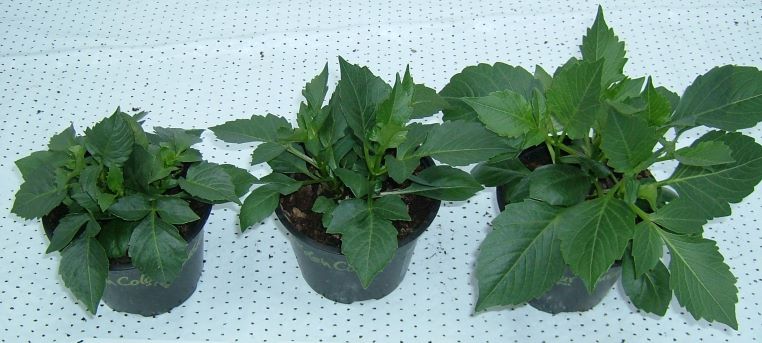Please click here to access the main AHDB website and other sectors.
- Home
- Knowledge library
- The use of chemical plant growth regulators on protected ornamental crops
The use of chemical plant growth regulators on protected ornamental crops
These pages provide guidance on the use of chemical plant growth regulators and highlight the findings of recent AHDB-funded trials on active ingredients new to ornamental horticulture.
Optimising the use of chemical growth regulators on ornamental crops
Controlling plant growth and development is essential for the production of quality plants to a schedule and height specification. Best practice requires that cultural and physical methods of growth control be considered first in preference to any chemical application. However, these techniques alone may be insufficient and often a combination of cultural and chemical growth control need to be integrated into any production programme.
Chemical plant growth regulators (PGRs) can produce a rapid, precise plant response and, as such, can be used both proactively and reactively when scheduling crops or when holding crops back in response to sudden changes in demand or the unseasonal effects of weather.
PGRs can be used to:
- Manipulate plant growth and improve habit
- Meet height specifications
- Schedule and hold back crops
- Induce, advance or delay the onset of flowering or cause flower abortion where required (as in the case of stock plant management)
- Improve other plant aspects such as leaf colour or reduce leaf size
PGRs deliver a range of commercial benefits, including:
- Reduced labour costs during production (less of a need for pinching in production and hand cleaning plants at dispatch)
- Reduced crop wastage through improved scheduling and improved grade out
- Reduced transport cost by potentially permitting more plants per trolley
- Reduced water use
- Potential for increased crop production (more plants per square metre)
There are, however, concerns relating to the use of PGRs:
- Potential phytotoxicity if used incorrectly
- Variable crop response
- Persistence in inert materials and growing media
- Increased reliance on plant protection products
The main PGRs currently authorised and used on ornamentals in the UK include: chlormequat (Stabilan 750), daminozide (B-Nine SG, Dazide Enhance and Stature) and paclobutrazol (Bonzi and Pirouette).
Aiming to broaden the range of PGRs available to growers, AHDB-funded trials evaluated potential alternative active ingredients for use on bedding plants and poinsettia (AHDB projects PO 019a and 019b). Products examined included: Canopy (prohexadione calcium + mepiquat), Moddus/Primo Maxx II (trinexapac-ethyl), Regalis (prohexadione-calcium) and Terpal (ethephon and mepiquat).
Action points
- Plant species and varieties all respond differently to chemical plant growth regulators (PGRs), therefore small scale trials should be conducted prior to widespread use on new plant subjects
- Check product labels for crop-specific information on efficacy and phytotoxicity, and any operator safety requirements
- To maximise their effect, PGRs should be applied to new growth prior to any rapid extension
- Apply PGRs under dull, cool conditions, ideally late in the afternoon or early in the evening to prevent rapid drying on the leaf surface, ensuring adequate leaf absorption
- Do not treat plants that are under stress
- Make sure plants are well irrigated prior to treatment to avoid the need for irrigation soon after treatment. This will minimise the risk of washing the PGR off the leaves into the growing media, increasing the effect
- When applied as drenches to crops, be aware of any potential build-up of active ingredient in capillary matting and bench/floor coverings
Cultural and physical methods of growth control on protected ornamentals
Temperature, light, nutrition, irrigation and thigmotropism are all factors which can be amended or employed as a method of controlling plant growth.
Cultural and physical methods of growth control
Chemical plant growth regulators - active ingredients
Chemical plant growth regulators have differing modes of action by inhibiting natural plant growth hormones, an understanding of the active ingredients will help to get the most from the various products.
Chemical plant growth regulators - active ingredients
Chemical plant growth regulators - application
Applications of chemical plant growth regulators (PGRs) should be made at the appropriate growth stage and via the recommended method to achieve the desired effect.
Chemical plant growth regulators - application
Potential adverse effects of chemical plant growth regulator applications
Potential adverse effects of PGR applications include leaf yellowing, plant stunting, delayed flowering and petal bleach, all of which will negatively impact final plant quality.
Potential adverse effects of plant growth regulator applications
Other chemicals that may affect ornamental plant growth
Other chemicals such as plant protection products and fertilisers can also impact plant growth and should be accounted for within any PGR programme.
Other chemicals that may affect ornamental plant growth
Useful links
For further general information on spray application and to hear about recent work on plant growth regulators for protected ornamentals, follow the links below:
Improving the spray application of plant protection products to crops
Evaluation of plant growth regulators on bedding plants
Download the original version of this factsheet as a PDF
Authors
Authors – Chloe Whiteside, Jill England and David Talbot, ADAS Horticulture.
Original authors – Jill England and David Talbot, ADAS Horticulture.
Web page content correct as of May 2021.
The result of effective applications of a chemical plant growth regulator on Dahlia (left and middle) to manipulate plant growth

Courtesy and copyright of ADAS Horticulture.
Topics:
Sectors:
Tags:

